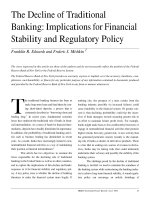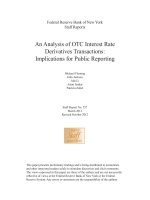Innovations in Credit Risk Transfer: Implications for Financial Stability docx
Bạn đang xem bản rút gọn của tài liệu. Xem và tải ngay bản đầy đủ của tài liệu tại đây (268.31 KB, 47 trang )
Innovations in Credit Risk Transfer:
Implications for Financial Stability
1
Darrell Duffie
Stanford University
Draft: July 2, 2007
Banks and other lenders often transfer credit risk in order to liberate capi-
tal for further loan intermediation. Beyond selling loans outright, lenders are
increasingly active in the markets for syndicated loans, collateralized loan obliga-
tions (CLOs), credit default swaps, credit derivative product companies, “spe-
cialty finance companies,” and other financial innovations designed for credit
risk transfer. My purpose here is to explore the design, prevalence, and effec-
tiveness of credit risk transfer. My focus will be the costs and benefits for the
efficiency and stability of the financial system.
In addition to allowing lenders to conserve costly capital, credit risk transfer
can improve financial stability by smoothing out the risks among many investors.
1
I am grateful for motivation from Claudio Borio and for initial conversations with Richard Cantor, Mark
Carey, Larry Forest, Michael Gordy, Serena Ng, David Rowe, and Kevin Thompson. I am especially grateful
for research assistance by Cliff Gray and Andreas Eckner, and for technical assistance from Linda Bethel and
Nicole Goh. I have benefited from comments, many of which remain to be reflected in a future draft, by Tobias
Adrian, Scott Aguais, Adam Ashcraft, Jesper Berg, Claudio Borio, Eduardo Canabarro, Richard Cantor, Mark
Carey, Moorad Choudhry, David Evans, Larry Forest, Michael Gordy, Jens Hilscher, Myron Kwast, Joseph
Langsam, Sergei Linnik, Alexandre Lowenkron, Joseph Masri, Matthew Pritsker, Til Schuermann, Hisayoshi
Shindo, David Shorthouse, Roger Stein, Kevin Thompson, and Anthony Vaz. I have also benefited exceptionally
by discussions provided by Kenneth Froot and Mohammed El-Erian at the Sixth Annual Conference of the Bank
of International Settlements at Brunnen in June, 2007, as well as from comments by others at this conference
and at the Financial Advisory Roundtable of the New York Federal Reserve. Duffie is also with The National
Bureau of Economic Research.
1
For example, a bank can substitute large potential exposures to direct borrowers
with smaller and more diversified exposures.
2
Even if the total risk to be borne
were to remain within the banking system, credit risk transfer allows banks to
hold less risk, because of diversification. In practice, some risk is transferred out
of the banking system, for example to institutional investors, hedge funds, and
equity investors in specialty finance companies, all of whom are not as critical
as banks for the provision of liquidity.
If credit risk transfer leads to more efficient use of lender capital, then the
cost of credit is lowered, presumably leading to general macroeconomic benefits
such as greater long-run economic growth. Cebenoyan and Strahan [2004] find
that banks that manage their credit risk by both buying and selling loans on the
secondary market have a ratio of capital to risky assets that is about 7% or 8%
lower than that of banks that do not participate in this market. Further, they
conclude, banks that “appear to rebalance their risk through both purchase and
sale have capital ratios about 1.0% to 1.3% points lower than banks that just sell
loans, and this difference is statistically significant.” Goderis, Marsh, Castello,
and Wagner [2006] estimate that banks issuing CLOs permanently increase their
target loan levels by about 50%.
An argument against credit risk transfer by banks, particularly in the case
of CLOs, is that it leads to greater retention by banks of “toxic waste,” assets
that are particularly illiquid and vulnerable to macroeconomic performance.
Further, a bank that has transferred a significant fraction of its exposure to a
2
Demsetz [1999] provides evidence favoring the hypothesis that banks that sell loans in order to diversify
their loan portfolios.
2
borrower’s default has lessened its incentive to monitor the borrower, to control
the borrower’s risk taking, or to exit the lending relationship in a timely manner.
As a result, credit risk transfer could raise the total amount of credit risk in
the financial system to inefficient levels, and could lead to inefficient economic
activities by borrowers. It has also been suggested, for example by Acharya and
Johnson [2007], that because a bank typically has inside information regarding a
borrower’s credit quality, the bank could use credit risk transfer to exploit sellers
of credit protection. Credit risk transfer also generates complex structured credit
products, including collateralized debt obligations (CDOs), whose risks and fair
valuation are difficult for most investors and rating agencies to analyze.
I will pay particular attention to the market imperfections that underly the
costs and benefits of credit risk transfer, and I will venture some opinions about
how the tradeoffs between costs and benefits have gotten us to where we are. I
will bring up the influences of our regulatory regime, especially with regard to
bank capital regulation and accounting disclosure standards.
Credit risk transfer is intimately linked with innovations in security design,
beginning with the emergence of collateralized mortgage obligations around
1980. As I will emphasize here, banks and other lenders design securitiza-
tions and loan covenant packages with the objective of reducing the costs of
transferring credit risk to other investors.
With the goal of stimulating a productive debate, I offer the following sum-
mary of opinions, some of which are speculative and deserve to be the subject
of more research.
1. Credit risk transfer (CRT) leads to improvements in the efficient distri-
3
bution of risk among investors. The retention by banks of “toxic waste”
from securitization is likely to be accompanied by reductions in the effective
leverage of bank balance sheets as well as improvements in diversification
that increase the safety and soundness of the financial system.
2. Innovations in CRT security designs, especially default swaps, credit deriva-
tive product companies, collateralized loan obligations, and specialty fi-
nance companies, increase the liquidity of credit markets, lower credit risk
premia, and offer investors an improved menu and supply of assets and
hedging opportunities.
3. Even specialists in collateralized debt obligations (CDOs) are currently
ill equipped to measure the risks and fair valuation of tranches that are
sensitive to default correlation. This is currently the weakest link in CRT
markets, which could suffer a dramatic loss of liquidity in the event of a
sudden failure of a large specialty investor or a surprise cluster of corporate
defaults.
4. Loans that are sold or syndicated tend to have better covenant packages.
CRT is nevertheless likely to lead to a reduction in the efforts of banks
and other loan servicers to mitigate default risk. Retention by lenders of
portions of loans and of CLO toxic waste improve incentives in this regard.
5. Risk-sensitive regulatory capital requirements improve the incentives for
efficient CRT. Adjustments in regulatory capital standards for default cor-
relation, or at least granularity, would offer further improvements.
4
0
0.5
1.0
1.5
2.0
2.5
3.0
1995 97 99 2001 03 05
Collateralized debt obligations (CDO)
Asset-backed securities (ABS) (ex-HEL)
Mortgage-backed securities (MBS)
(trillions of US dollars)
Figure 1: Securitization of bank credit risk. Source: IMF
6. Financial innovations designed for more efficient credit risk transfer appear
to have facilitated a reduction in the degree to which credit is intermediated
by banks, relative to hedge funds, credit derivative product companies, and
specialty finance companies.
7. While the gross level of credit derivative and CLO activity by banks is
large, the available data do not yet provide a clear picture of whether the
banking system as a whole is using these forms of CRT to shed a major
fraction of the total expected default losses of loans originated by banks.
The recent dramatic growth of CRT markets is driven mainly by various
other business activities by banks and non-bank financial entities.
5
0
5
10
15
20
25
30
1997 99 2001 03 05 06
(trillions of US dollars)
Figure 2: Outstanding notional amount of default swaps. Source: British Bankers Association.
1 Recent Credit Risk Transfer Activity
Figures 1 and 2 illustrate the significant growth in credit risk transfer through
securitization and default swaps (CDS), respectively. Figures 3 and 4 provide
Bank of America estimates of the fractions of total CDS protection selling and
protection buying, respectively, that can be attributed to loan-portfolio risk
management in 2006. These figures also show that the majority of CDS credit
risk transfer performed by banks and securities dealers is due to trading on be-
half of clients, rather than loan-portfolio hedging. The volume of net credit risk
transfer away from banks’ loan portfolios through CDS protection is neverthe-
less estimated by Bank of America to be significant. Figures 3 and 4 imply that
net transfer of credit risk away from banks in 2006 through CDS was about 13%
of the $25 trillion CDS market, or about $3.2 trillion.
In order to judge whether banks are indeed laying off a significant fraction
6
of the risk in their own loan portfolios, I extended the study by Minton, Stulz,
and Williamson [2006] of U.S. bank activity in default swaps during 2001-2003.
Figure 5 shows that CDS positions by large U.S. banks during 2001-2006 grew
at an average compounding annual rate of over 80%. CDS positions now dra-
matically exceed loan assets.
3
Of all 5700 banks reporting to the Fed, large or
not, however, only about 40 showed CDS trading activity. Only three banks,
J.P. Morgan, Citigroup, and Bank of America, have accounted for the major-
ity of the CDS activity. For example, in 2006, according to new Chicago Fed
data obtained by personal request, J.P. Morgan reported total CDS positions
of approximately 4.7 times the size of its loan portfolio.
The buying and selling of CDS protection by large U.S. banks were relatively
balanced in all years except 2005, when net CDS protection buying was about
17% of the total principal in these banks’ loan portfolios. Table 1 provides a
numerical breakdown of this CDS activity. Given only the available data, it
is premature to conclude that banks are systematically using default swaps to
significantly reduce the total expected default losses in their loan portfolios.
They may be using default swaps to diversify their exposure to default risk.
Much of the CDS activity by the three largest bank users of CDS is likely to be
driven by CDS trading that is not related directly to loan hedging.
3
Minton, Stulz, and Williamson [2006] selected banks with assets over $1 billion as of 2003. Of the 19 large
banks in their study, there remain 13 due to consolidation. I follow the large banks tracked by Minton, Stulz,
and Williamson [2006], or their successors. I am grateful to Cliff Grey for assistance in analyzing these data.
Of the 345 banks with assets in excess of $1 billion, however, Minton, Stulz, and Williamson [2006] found that
only 19 had used credit derivatives. Of these, 17 banks were net protection buyers.
7
Table 1: Aggregate Loans and CDS positions, in billions of U.S. dollars, for large U.S. banks (those with at least
$1 billion in assets as of 2003). The first three columns are totals for the 19 banks within the sample of Minton et
al (2006), or their successors. Bank-specific data for “Total Loans” (BHCK2122), “CDS Bought”(BHCKA535),
and “CDS Sold” (BHCKA534) are from the Federal Reserve Bank of Chicago’s bank holding company data,
2001-2006, using fourth-quarter holdings. The Federal Reserve data are from FR Y-9C reports filed by the banks
(www.chicagofed.org).
Year Total CDS CDS CDS CDS CDS Bought CDS Sold CDS Net
Loans Bought Sold Gross Net % of loans % of loans % of loans
2001 2125 217 220 437 −2 10.2% 10.3% 0.0%
2002 2238 342 288 630 54 15.3% 12.9% 2.4%
2003 2379 520 469 988 51 21.8% 19.7% 2.1%
2004 2671 1179 1092 2270 87 44.1% 40.9% 3.3%
2005 2891 3002 2518 5520 484 103.8% 87.1% 16.7%
2006 3298 4165 4094 8259 71 126.1% 124.1% 2.1%
2 Why does a bank transfer credit risk?
When transferring credit risk to another investor, a bank suffers two major costs:
1. The lemon’s premium that the investor charges because of the bank’s inside
information regarding the credit risk. For example, as suggested by Akerlof
[1970], if the bank offers to sell a loan at par, then the investor infers that
the loan is worth at most par, so offers less, whether or not the loan is truly
worth par. That banks indeed have private information about a borrower’s
default risk, and that banks are likely to suffer lemon’s premia from loan
sales, are consistent with research by Dahiya, Puri, and Saunders [2003]
and Marsh [2006], who show that sale of a bank loan is associated with a
significant drop in the price of the borrower’s equity.
8
Loan
portfolios
7%
Misc.
1%
Banks and
dealers
(Trading
portfolios)
33%
Insurers
18%
Pension funds
5%
Corps.
2%
Mutual funds
3%
Hedge funds
31%
Figure 3: Estimated breakdown of CDS buyers of protection. Source: Bank of America, March 2007.
2. Moral hazard, resulting in inefficient control by the lender of borrowers’
default risks. For example, a bank has less incentive to control the credit
quality of a loan that it sells than of a loan that it retains. Thus, the
price received from the sale of a loan is less than it would be if the bank
controlled the borrower’s default risk as the sole owner of the loan asset.
Legal, marketing, and other arrangement costs for credit risk transfer are
relevant, but will not be within our primary focus.
The principle benefits of credit risk transfer are diversification and a reduction
in the costs of raising external capital for loan intermediation. As suggested by
Froot, Scharfstein, and Stein [1993] and Froot and Stein [1998], we expect an
equilibrium in which a lender transfers credit risk until the costs of doing so
exceed the benefits associated with lower capital requirements relative to the
scale of the lending business.
9
Loan
portfolios
20%
Misc.
1%
Banks and
dealers
(Trading
portfolios)
39%
Insurers
2%
Pension funds
2%
Corps.
2%
Mutual funds
6%
Hedge funds
28%
Figure 4: Estimated breakdown of CDS sellers of protection. Source: Bank of America, March 2007.
If financial markets are imperfect, credit risk transfer in the form of CDOs can
also provide specialized investors with access to relatively low-risk investments
that might otherwise be available only at a higher price. Extremely-low-risk
securities such as government bonds are in demand by investors with a rela-
tively high value for liquidity, because they are easily exchanged
4
and have high
transparency. There is a relatively small supply of extremely highly rated (Aaa)
corporate debt instruments, which often command a price premium associated
with liquidity. A “super-safe” corporate bond, moreover, has adversely skewed
risk, paying off in full with high probability, but losing roughly half of its prin-
cipal value in default. CDO payoffs are not so adversely skewed because their
exposure to any one default is normally a small fraction of the CDO principal.
Investors with a low demand for liquidity but a high demand for safety benefit
from access to senior CDOs, which offer a moderate reward to patient insti-
4
In the United States, Treasuries and agency securities are among the few securities accepted by Fedwire, for
same-day secure exchange in the interbank market.
10
0
1
2
3
4
5
6
7
8
9
2001 2002 2003 2004 2005 2006
Trillions of US dollars
Total loans Total CDS
Figure 5: Aggregate U.S. Large-Bank Loans and CDS positions (Data: Federal Reserve Bank of Chicago
(2006).
tutional investors, such as pension funds and insurance companies, for bearing
a small amount of default risk, and for bearing some illiquidity.
5
Gale [1992]
emphasizes the value of “standard securities,” those for which investors have
overcome much of the fixed costs of understanding the security design. One of
the causes of growth in the CDS and CDO markets is the relative standard-
ization of collateralized debt obligations and default swaps, creating a positive
feedback effect on market acceptance.
Consider a bank whose assets consist of $100 billion of risky loans, and sup-
pose that it is optimal or required by regulation to hold $9 billion in capital as a
buffer against default risk on this portfolio. The capital buffer mitigates distress
costs to the bank and systemic risk costs to the financial system. At first, we
suppose that the only available form of credit risk transfer is the outright sale
5
This motivation for innovation is related to, but somewhat different than, that of Allen and Gale [1988].
11
0
2
4
6
8
10
12
14
16
18
2001 2002 2003 2004 2005
Net CDS protection as a fraction of loans (percent)
0
2
4
6
8
10
12
14
16
18
2001 2002 2003 2004 2005 2006
Net CDS protection as a fraction of loans
Figure 6: Net CDS protection bought as a fraction, in percent, of loan portfolio size.
of loans in the secondary market. If the frictional costs of raising capital are
high enough relative to the above-named frictional costs associated with selling
loans, and if loan origination is sufficiently profitable, then the bank increases
the return on its capital by selling loans for cash (and for regulatory capital
relief) in order to intermediate additional loans. Unless some loans are more
costly to sell than others, the bank should sell loans as soon as possible after
their origination, holding only the capital necessary to cover the loans while
they are temporarily on the bank’s balance sheet. As we shall discuss, CDS
hedging and loan syndication can be near substitutes for loan sales.
12
3 What credit risk to keep, and what to transfer?
Still supposing that credit risk transfer occurs only through the outright sale of
loans, suppose that the costs of selling loans diverge widely across the pool of
loans that a bank originates. Then we expect the bank to sell only those loans
that provide the greatest benefit in capital reduction net of the costs of sale. The
marginal loan sold is that for which the marginal benefit from the associated
release of capital is equal to the marginal loan-sale costs. The moral-hazard
and lemons-premium costs described above are typically related to the level of
default risk. If the capital released from the sale of a loan does not depend on
the quality of the loan, then only the lowest-quality loans would be retained.
Given that a bank’s chosen or mandated level of capital ought to be sensitive to
the riskiness of the bank’s loan portfolio, however, the amount of capital that
is liberated by the sale of a high-risk loan is greater than that for a low-risk
loan. Depending on the circumstances, selling risky loans could be preferred
over selling safe loans. Assuming that regulatory capital is binding, the “Basel
II” capital accord is an improvement in this respect. Notably, high-risk loans
are increasingly not held by traditional banks, as indicated in Figure 7. Loan
syndication, which from the viewpoint of the lead bank has some of the essence
of a loan sale, is also increasingly oriented toward speculative-grade loans, as
indicated in Figure 8.
Consistent with the above cost-benefit tradeoff, Drucker and Puri [2006] show
that loans that are sold appear to be those with relatively low monitoring costs.
For example, sold loans tend to have more restrictive covenant packages than
13
0
100
200
300
400
500
600
1987 89 91 93 95 97 99 2001 03 05
Leveraged loan issuance
held by institutional investors
Leveraged loan issuance
held by banks
High-yield bond issuance
(billions of US dollars)
Figure 7: Bank and non-bank investment in leveraged loans. Source: IMF.
unsold loans. Drucker and Puri [2006] also find that the covenant packages tend
to be more restrictive when rating agencies disagree on the borrower’s rating,
a signal of informational asymmetries. Drucker and Puri [2006] note that these
covenant packages actually appear to be frequently designed to ease the loan
sale, given that over 60% of loan sales occur within a month of origination. More
than half of sold loans are eventually resold, further indicating the intention of
creating a loan instrument that will be liquid in the secondary market. Of sold
loans, nearly 90% have a credit rating. Of unsold loans, only about 40% have
a credit rating. As for the incentive to sell loans that tie down a significant
capital buffer, Drucker and Puri [2006] indeed find that, after controlling for
other relevant predictors, having a junk credit rating increases the likelihood of
sale significantly.
The picture emerges: Banks often sell loans that are designed specifically
for an intermediation profit rather than for a long-run investment profit, using
14
60
50
40
30
20
2000 2001 2002
2003 2004
2005
2006 2007
10
0
1,000
900
800
700
600
500
400
300
200
100
0
Sub-investment grade (right-hand scale)
Investment grade (right-hand scale)
Proportion of sub-investment (left-hand scale)
US$ billions
Per cent
Figure 8: Decomposition of syndicated loan issuance by investment grade and sub-investment grade. Source:
Bank of England, Financial Stability Report (2007).
more restrictive covenant packages that mitigate selling costs. The riskier loans
are more the likely to be sold, controlling for other effects, perhaps because they
tie down more bank capital.
3.1 Fractional retention as a signal or commitment
If a fraction of a loan can be sold, that fraction optimally trades off capital
relief against selling costs. For example, in the case of selling costs arising from
information about borrower quality that is held privately by banks, Leland and
Pyle [1977] use a signalling equilibrium to model the partial sale of an asset by
an informed owner. The loan seller signals a higher-quality loan by the costly
retention of a larger fraction of the loan. Whether a bank can credibly commit
15
0
20
40
60
80
100
120
140
160
180
200
1991 1992 1993 1994 1995 1996 1997 1998 1999 2000 2001 2002 2003 2004 2005
Year
Trading Volume ($bil)
Figure 9: Secondary-market loan sales. Source: Drucker and Puri (2006).
not to later sell the portion of the loan that was originally retained may depend
on the development of a reputation for retention that is worth keeping. There
is clearly scope for further theory in this direction.
Alternatively, one can consider the case of selling costs that are associated
with moral hazard with regard to costly efforts by a bank to control the default
risk of the borrower, in the spirit of Gorton and Pennachi [1995].
We can consider a simple illustrative theoretical framework that will be ex-
tended when we consider the design of collateralized loan obligations. Suppose
that a bank is indifferent between having one dollar of additional assets, against
which capital must be retained, and having b dollars of additional capital. For
example, if b = 0.99, then there is a shadow price of 1% for holding assets on the
balance sheet. Unless the cash to be liberated by the loan sale is large relative
to the bank’s capital, the marginal value of each dollar of capital liberated by
the loan sale would not depend on the fraction of the loan sold. Consider the
16
sale by the bank of some fraction f of a loan whose market value would be par if
market participants assume a minimally acceptable effort by the bank to control
default losses. The bank’s total value for what is sold and what is retained is
thus
U(f, x) = f(1 + x) + b(1 − f)(1 + x) − C(x), (1)
where x is a candidate for the improved value of the loan that could be achieved
through efforts by the bank to lower the borrower’s default risk, and where C(x)
is the bank’s cost of achieving this additional loan value x.
The buyer of the loan understands that the bank, when choosing an effort
level, focuses only on the value of the retained fraction of the loan net of moni-
toring costs, therefore solving
max
x
(1 − f)b(1 + x) − C(x). (2)
Letting X(f) be the optimal effort for a sold fraction f, the bank thus faces the
loan-sale decision
max
f
U(f, X(f)). (3)
For example, suppose that the effort necessary for a fractional increase in
loan value of x has a proportionate cost to the bank of C(x) = kx
2
, for some
coefficient k. Then, from the first-order condition
6
for (2), we have X(f) =
(1 − f)b/(2k). Substituting X(f) into (3), the optimal fraction of the loan to
sell
7
is
f
∗
=
k
b
1 +
b
2k
(1 − b)
1 −
b
2
. (4)
6
The first-order condition for optimal effort x
∗
by the bank implies that C
′
(x
∗
) = (1 − f )b.
7
This is the first-order condition. The second-order condition for a maximum is always satisfied. One should
restrict attention to cases with f
∗
< 1.
17
38%
35%
20%
0
5
10
15
20
25
30
35
40
Private Public
unrated
Public rated
Fraction syndicated (per cent)
Figure 10: Estimates by Sufi (2007) of syndicated loan retention by lead arranger.
For the anticipated case of b near 1, we have f
∗
≃ 2k(1 − b). For example, at
k = 25 and b = 0.99, the optimal fraction to sell is about f
∗
= 50%. Relative to
the value of the loan if it were sold in its entirety, the bank chooses to protect its
investment in the retained portion of the loan by efforts that lower the market
value of total loan default losses by about X(f
∗
) = 1%, at a monitoring cost
C(0.01) of about 25 basis points of the loan value. Net of the cost of tying
down capital in the retained portion, 1 − b = 1% of the 50% retained, the bank
achieves a net improvement in value for the loan of about 25 basis points.
Consistent with the role of monitoring in explaining the incentive to sell a
particular loan, Sufi [2007] finds that the fraction of a syndicated loan retained
by the lead arranger is about 38% for a private-firm borrower, about 35% for a
public but unrated borrower, and about 20% for a public and rated borrower, as
illustrated in Figure 10. The fraction retained is lower for more reputable lead
arranging banks. By studying the relationship over time between the borrower
18
and the lead arranger, Sufi finds more support for the moral-hazard motive
for loan retention than for the lemon’s-premium motive. A longer borrower-
lender relationship implies a greater lemon’s premium, but presumably lowers
monitoring costs. Sufi’s data do not support greater loan retention with a prior
lender-borrower relationship.
Rather than the sale of a loan, buying default-swap protection can be used
to transfer credit risk. If the maturity of a loan is identical to that of the default
swap, then buying CDS protection is essentially equivalent to loan sales, ignoring
the risk of default swap counterparty performance. Loan sales are currently
somewhat superior to CDS protection from the viewpoint of regulatory capital
and accounting disclosure. A cross-jurisdictional review of regulatory capital
and disclosure treatment of CDS protection of bank loans is provided in the
Joint Forum Report on Credit Risk Transfer, BIS [2005]. Typically, a CDS-
protected loan is treated for regulatory-capital purposes as though it is a loan
that is guaranteed by a counterparty of the quality of the CDS protection seller,
subject to maturity matching and other provisions.
8
The Basel II accords will
provide a more uniform regulatory capital framework.
Duffee and Zhou [2001] provide a theory by which CDS protection of loans
with default swaps of shorter maturities than those of the loans can be effective
if the default risk is concentrated near or at the maturity of the loan. Arping
[2004] further shows that CDS protection buying by lenders can be more effec-
tive without a maturity match, when balancing the costs of moral hazard by
8
An important distinction across jurisdictions is whether the default swap must cover restructuring in order
to quality for regulatory capital reduction, as in Europe.
19
2001
2002
2003
2004
2005
2006
2007
1st Qtr
100
90
80
70
60
50
40
30
20
10
0
$ Billion
USD Europe Other
Figure 11: Issuance of CLOs by year and region. Source: Morgan Stanley. Data from Thompson Financial
show total 2006 issuance of CDOs backed by high-yield bonds of $164 billion, roughly consistent with the Morgan
Stanley data. Fitch data indicate European CLOs in 2006 of approximately 30 trillion Euros. SIFMA reports
balance-sheet CDO issuance in 2006 of about $70 billion, based on Thompson Financial data.
the lender against the benefits of the borrower’s “free riding” on the lender’s
incentive to bail out the borrower.
4 Collateralized Debt Obligations
A collateralized debt obligation (CDO) is a debt security whose underlying col-
lateral is typically a portfolio of bonds (corporate or sovereign) or bank loans.
The collateral is held by a special purpose vehicle (SPV), a corporation or trust
whose only purpose is to collect collateral cash flows and pass them to CDO
investors. CDOs backed by consumer loans, such as mortgages or credit card
debt, are often called “asset-backed securities” (ABS). Those backed by cor-
porate loans are usually called collateralized loan obligations. CDOs allocate
interest income and principal repayments from the asset collateral pool to pri-
20
Ongoing
Communication
Collateral
Manager
Trustee
Underlying
Securities
(Collateral)
CDO
Special Purpose
Vehicle (SPV)
Hedge Provider
(If Needed)
Senior Fixed/
Floating Rate
Notes
Mezzanine
Fixed/Floating
Rate Notes
Subordinated
Notes/Equity
Figure 12: Typical CDO contractual relationships. Source: Morgan Stanley
oritized CDO securities, often called tranches. While there are many variations,
a standard prioritization scheme is simple subordination: Senior CDO notes are
paid before mezzanine and lower-subordinated notes are paid, with any residual
cash flow paid to an equity piece.
A typical contractual framework for CDOs is pictured in Figure 12. Issuance
of CLOs is growing rapidly, especially in Europe, as indicated in Figure 11.
The first generation of CDOs, appearing around 1980, were collateralized
mortgage obligations (CMOs). Prioritizing the cash flows of a mortgage port-
folio into relatively low risk and high risk tranches led to improved liquidity
for mortgages and lower borrowing costs for homeowners. Notably, the CMO
market collapsed in 1994 with dramatic changes in the term structure of interest
rates and the failure of The Granite Fund, which had depended on unreliable
valuation and risk management methodology. After a year-on-year decline in
CMO issuance of 95%, the market subsequently recovered.
In 1997, Nations Bank issued one of the earliest major examples of a col-
21
lateralized loan obligation (CLO), illustrated in Figure 13. A senior tranche
of $2 billion in face value had priority over successively lower-subordination
tranches. The ratings assigned by Fitch are also illustrated. The underlying
pool of collateralizing assets consists of roughly 900 loans that had been pre-
viously made by NationsBank to various firms, most rated BBB or BB. Most
of these loans had floating interest rates. Any fixed-rate loans in the collateral
pool were significantly hedged against interest rate risk by having the SPV en-
ter payer (fixed-to-floating) interest-rate swaps. The majority of the (unrated)
lowest tranche was retained by NationsBank, presumably based on the adverse-
selection and moral-hazard costs of selling that we have explained in the context
of outright loan sales.
9
4.1 Theories of CDO Design
We have discussed the role of moral hazard and adverse selection as motives
for retention by the lender in the case of an outright loan sale. Given a CDO
design, essentially the same story applies to retention of CDOs by the issuer.
A CDO also presents moral hazard and adverse selection through the lender’s
opportunity to select the loans for the pool of CDO collateral. The CDO design
problem is to develop an algorithm for assigning cash flows from the collateral
pool to each CDO tranche so as to maximize the sum of the market value for
9
A cash-flow CDO is one for which the collateral portfolio is not actively traded by the CDO manager,
implying that the uncertainty regarding interest and principal payments to the CDO tranches is determined
mainly by the number and timing of defaults of the collateral securities. The NationsBank CLO illustrated in
Figure 13 is an example of a cash-flow CDO. A market-value CDO is one for which the CDO tranches receive
payments based essentially on the mark-to-market returns of the collateral pool, which depends on the trading
performance of the CDO asset manager.
22
Obligors
$2.164 billion
Issuer
A. $2 billion
(AAA)
Interest Rate Swaps
B. $43 million
(A)
C. $54 million
(BBB)
D. $64 million
(NR)
Figure 13: NationsBank 1997-1 CLO tranches (Source: Fitch)
what is sold and the effective value to the issuer for what is retained.
An additional incentive for the creation of CDOs is the demand by certain
investors for debt instruments of a given credit quality. Those developing struc-
tured credit products have pointed to such clientele effects, with limited if any
support from academic research. In perfect capital markets, the pricing of risk
is identical across all assets. Issuing high quality debt and retaining the residual
has no benefit over the converse issuance strategy, along the lines Modigliani and
Miller [1958]. If, however, there is a pool of investor capital that is dedicated
to relatively high-quality debt instruments, the supply of such instruments to
the market can lag the demand, and in the meantime an issuer of asset-backed
securities can earn attractive rents. As illustrated in Figure 14, the structured
finance industry has indeed created a very large supply of high quality fixed-
income assets out of a pool of lower quality assets, by concentrating the credit
risk into a small amount of highly risky assets.
23
4.45%
9.81%
10.65%
12.52%
0.89%
1.28%
0.08%
$-
$1,000
$2,000
$3,000
$4,000
$5,000
$6,000
$7,000
Aaa Aa
A
Baa
Ba B
Caa
Original rating
Billions of US dollars
0%
2%
4%
6%
8%
10%
12%
14%
Lifetime impairment rates
Total Issuance (as of 2005)
Lifetime Principal Impairment Rates (as of 2006)
Figure 14: Structured finance: outstanding issuance and impairment rates by rating. Source: Moodys.
Evidence that some of the impetus for collateralized debt obligations is driven
by the demand for certain classes of securities, rather than merely by lemon’s
premia or moral-hazard on the part of the original lender, is the fact that a
typical CDO structure incorporates multiple classes of relatively senior tranches
that are all “sold out.” Under only the incentives associated with moral-hazard
or lemon’s premia, the intermediate tranches would be retained in different
proportions by the issuer.
Just as has long been claimed by CDO asset managers, it is likely the case that
the sold-out tranches add value to the CDO structure by feeding clienteles with
assets that are highly valued by them and are in relatively short supply. Coval,
Jurek, and Stafford [2007] propose that investors in senior CDOs are simply
unaware that these instruments are exposed to significant levels of systematic
24
Multi-Asset
Investment
Manager
22%
LF
Division
of Bank
15%
Hedge Fund
16%
Private Equity
13%
New
Managers
39%
Existing
Managers
61%
LF Specialist
33%
Figure 15: New European CLO issuers in 2006. Source: Fitch.
risk, given that only a significant economic downturn would generate sufficient
losses to impair relatively senior tranches. The degree to which the issuance
of CDOs is driven by “behavioral” demand, or is based on a shortage of assets
with similar risk and return characteristics is an open question. In any case, it
is my presumption that sub-tranching of the unretained portions of CDOs is not
explained by traditional theories of security design that are based on adverse
selection and moral hazard.
Incidentally, the latest available data regarding returns on the equity pieces
of CDOs is rather discouraging. Of all 59 CLO deals that had terminated in
time for Moodys’ January 2007 report on CDO equity returns, the mean across
deals of the internal rate of return on the equity pieces of CLOs was estimated
by Moodys to be 2.35% with a standard deviation of 21.14%. For collateralized
bond obligations, the mean IRR of the equity tranches across 36 terminated
deals was −14.2% with a standard deviation of 43.5%.
In general, an issuer has an incentive to design a CDO in such a manner
that the issuer sells most or all of the senior tranches and retains a significant
25









